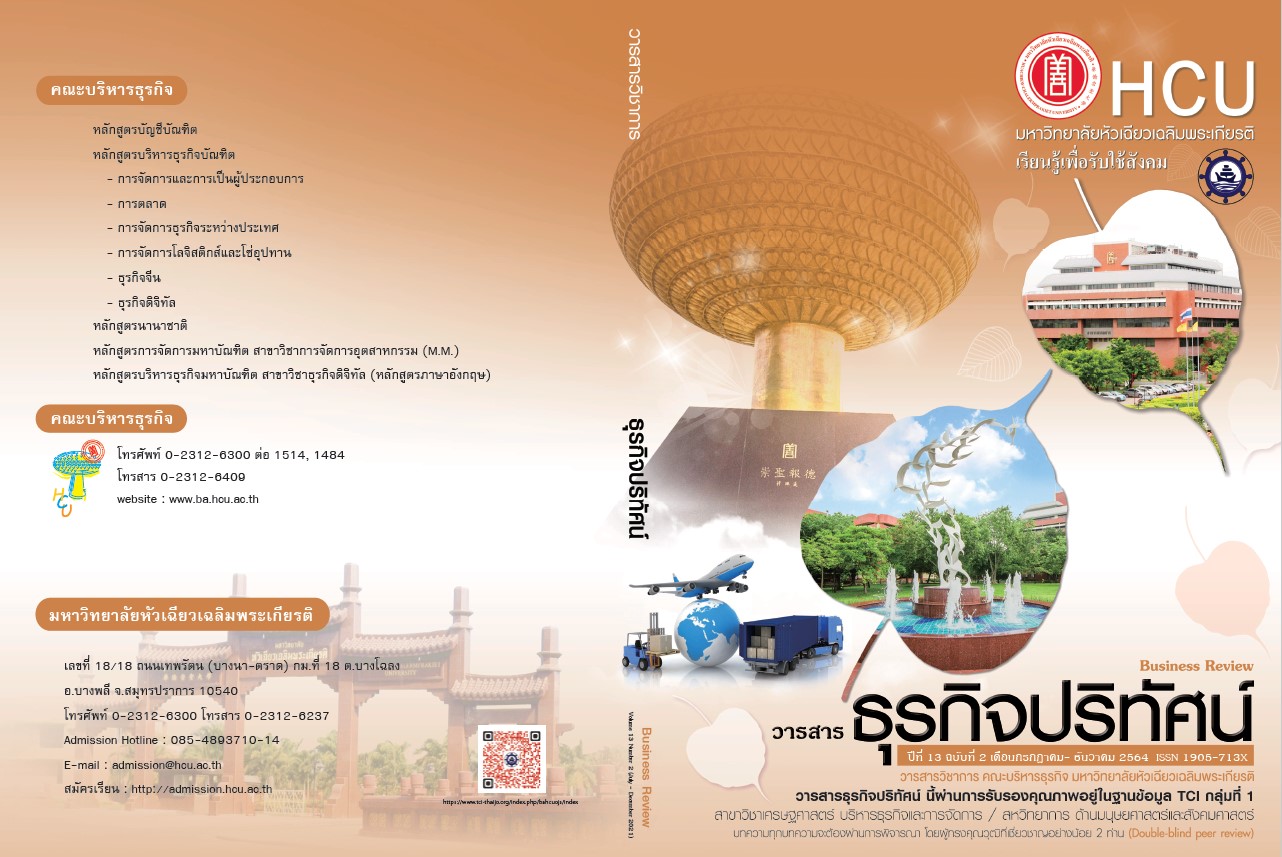Guanxi of Thai-Chinese Entrepreneurs Influencing to a Success for Business
Keywords:
Background, Guanxi’s networking, Access to resources, Success of BusinessAbstract
The objectives were to study the Guanxi’s networking of Thai entrepreneurs and to study the Guanxi’s networking factors influencing success of Thai-Chinese entrepreneurs’ businesses. The population of this study is the successful New-Era Thai-Chinese entrepreneurs in Thailand by using random sampling of 150 sample with questionnaires technics. Analyzing by using descriptive statistics and Structure Equation Model: SEM or the analysis of relationship structures among variable causing factors. The study was found that different backgrounds were positively indifference, experiencing backgrounds of accessing to resources were positively influencing factors, different aging backgrounds were positively influencing factors to the success of business with the meaning by statistic of 0.05.The outcomes of analyzing the Structure Equation Model and the Guanxi’s networking has positive influence both directly and indirectly to the success of business through the access of resources. This explained the success of business as 26 percent (R2 =0.26).
References
กัลยา วานิชย์บัญชา. (2560). การวิเคราะห์สถิติขั้นสูงด้วย SPSS for Window (พิมพ์ครั้งที่ 12). กรุงเทพฯ: ห้างหุ้นส่วนจํากัด สามลดา.
เกริกเกียรติ พิพัฒน์เสรีธรรม. (2524). การเปลี่ยนแปลงทางสังคมเศรษฐกิจการเมืองกับการรวบอำนาจทางเศรษฐกิจโดยเอกชนในประเทศไทย. ใน การขยายตัวของระบบทุนนิยมในประเทศไทย, บรรณาธิการโดย สมภพ มานะรังสรรค์. กรุงเทพฯ: สร้างสรรค์.
แววมยุรา คำสุข, มรกต กำแพงเพชร, อาภรณ์ ภู่เผือก, ปรียา ศิวเวชช,พัฒนพงศ์ เพ็งจันทร์ และ ฉัตรแก้ว ฮาตระวัง. (2562). รูปแบบปัจจัยเชิงสาเหตุที่มีอิทธิพลต่อความจงรักภักดีของผู้บริโภคในการใช้แอปพลิเคชันอาลีเอ็กซ์เพลสของจีนในประเทศไทย. วารสารวิชาการธุรกิจปริทัศน์, 11(1), 111-126.
วิภาวี สุวิมลวรรณ. (2561) ผู้ประกอบการไทยเชื้อสายจีนในบริบทของการสร้างมโนทัศน์ความเป็นไทยระหว่างพ.ศ.2488-2500. วารสารวิชาการธุรกิจปริทัศน์, 10(1), 207-218.
Best, J. W., & Kahn, J. V. (1998). Research in education. 8th ed. Boston: Allyn and Bacon.
Cochran, W. G. (1977). Sampling techniques (3rd ed.). New York: John Wiley & Sons.
Davidsson, P., & Honig, B. (2003). The role of social and human capital among nascent entrepreneurs. Journal of Business Venturing, 18(3), 301–331.
Edelman, L., & Yli. R. H. (2010). The impact of environment and entrepreneurial perceptions on venture‐creation efforts: Bridging the discovery and creation views of entrepreneurship. Entrepreneurship: Theory and Practice, 34(5), 833–856.
Fornell, C., Johnson, M. D., Anderson, E. W., Cha, J., & Bryant, B. E. (1996). The American customer satisfaction index: nature, purpose, and findings. Journal of marketing, 60(4), 7-18.
Hair, J. F., Sarstedt, M., Ringle, C. M., & Mena, J. A. (2012). An assessment of the use of partial least squares structural equation modeling in marketing research. Journal of the academy of marketing science, 40(3), 414-433.
Hoang, H., & Antoncic, B. (2003). Network-based research in entrepreneurship: A critical review. Journal of Business Venturing, 18(2), 165–187.
Jin A. (2006). Guanxi Networks in China: Its Importance and Future Trends. China &World Economy, 14(5), 105 – 118.
Lau, V.P., Shaffer, M.A., & Au, K. (2007). Entrepreneurial career success from a Chinese perspective: Conceptualization, operationalization, and validation. Journal of International Business Studies, 38(1), 126–146.
Likert, R. E. N. S. I. S. (1972). Likert technique for attitude measurement. Social Psychology: Experimentation, Theory, Research, Sahakian, WS (Ed.). Intext Educational Publishers, Scranton, USA., ISBN-13: 9780700223879, 101-119.
Lomax, R. G., & Schumacker, R. E. (2012). A beginner's guide to structural equation modeling. New York, NY: Routledge Academic.
Lee,D.Y., and Dawes,P.L. (2005). Guanxi,Trust,and Long-term Orientation in Chinese Business Mand Arkets, Journal of International Marketing, 13 (2), 28-56.
Langenberg, E. A. (2007). Guanxi and Business Strategy: Theory and Implications for Multinational Companies in China. New York: Physica-Verlag Heidelberg.
Luo, Y., Huang, Y., & Wang, S.L. (2012). Guanxi and organizational performance: A metaanalysis. Management and Organization Review, 8(1), 139–172.
Chen, M., Chang, Yu., & Lee, C. (2015). Creative entrepreneurs' guanxi networks and success: Information and resource Journal of Business Research, 68, 900-905.
Peng, M.W., & Luo, Y. (2000). Managerial ties and firm performance in a transition economy: The nature of a micro–macro link. Academy of Management Journal, 43(3), 486–501.
Sheng, S., Zhou, K.Z., & Li, J.J. (2011). The effects of business and political ties on firm performance: Evidence from China. Journal of Marketing, 75(1), 1–15.
Downloads
Published
How to Cite
Issue
Section
License
All articles published in the Business Administration and Management Journal Review are copyrighted by the journal.
The views and opinions expressed in each article are solely those of the individual authors and do not represent those of Huachiew Chalermprakiet University or any other faculty members. Each author is fully responsible for the content of their own article. Any errors or issues found are the sole responsibility of the respective author.




